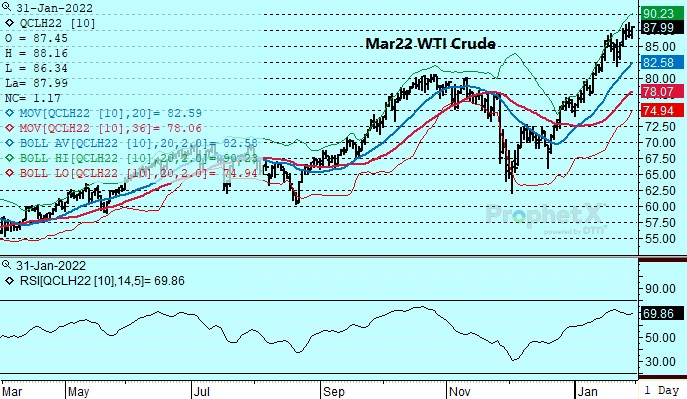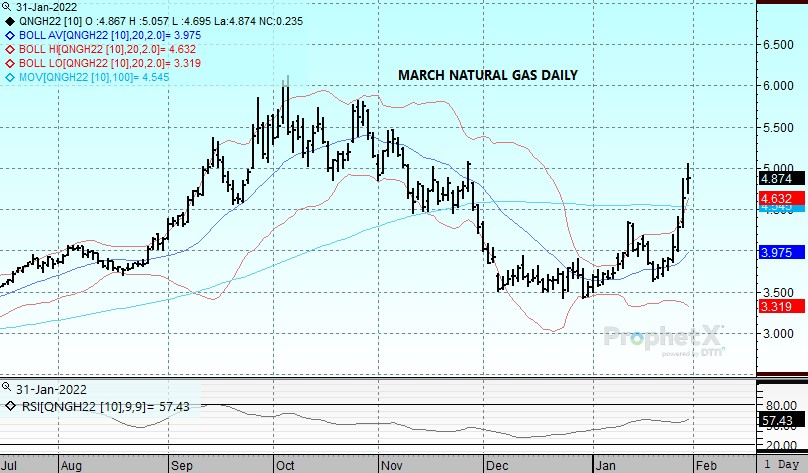Price Overview
The petroleum complex traded higher with underlying support continuing to be traced to concern over OPEC’s ability to meet planned output targets. Member countries pumped 28.01 mb/d in January, an increase of 210 tb/d from the prior month, but short of the 254 tb/d increase allowed under the supply deal. The agreement allowed for a 400 tb/d increase from all members and 254 tb/d shared by the 10 OPEC members participating in the deal. Their compliance with pledged cuts increased to 132 percent in January from 127 in December. The biggest rise came from Saudi Arabia which boosted output in line with the agreement. The second largest increase came from Nigeria following a lifting of a force-majeure on Forcados crude. Nevertheless, compliance in that country continues to lag and stands at 253 percent which is among the largest output shortfalls within the cartel. The group meets on Wednesday and is expected to stick with planned production increase of 400 tb/d although some members have expressed concern over the potential for current prices to encourage a marked expansion in shale production in 2022. Additional support was provided by the ongoing fear of an invasion by Russia against Ukraine, where oil moves through pipeline to Europe.
One factor that appears to have been overlooked is labor negotiations between the United Steelworkers and oil company lead negotiator Marathon Petroleum, who are facing a Tuesday deadline to agree on a new contract for US refinery and chemical plant workers. The contract expires at midnight on February 1st. The last nationwide strike occurred in 2015 and had a dramatic impact to the upside on the crack spreads. The talks have progressed slowly over the past two and a half weeks with small increases of 5.5 percent being offered over three years. According to Reuters if a strike is called it will likely be similar to the 2015 stoppage which impacted 20 percent of crude oil processing. The nationwide strike ended in mid-March. A sharp increase in diesel and gasoline prices could curb disappearance. In addition, the closing of refineries would reduce throughput that might undercut crude demand.


Natura Gas
Last weeks strength followed through in overnight trade as the active March opened sharply higher and tested the late November spike just above 5.00 early in the session before ending 23 ½ cents higher at 4.874. Extreme weather marked by a weekend storm on the East Coast, expectations for another winter storm to impact a large swath of the Midwest in the coming days, and extreme cold forecast for much of Texas late in the week juiced potential risk and flushed out panic buying. Although not expected to reach anywhere near the extreme levels seen last year with Winter Storm Uri, the risk of freeze-offs and spikes in ERCOT (Electric Reliability Council of Texas) total load that could exceed the highs seen with Uri has heightened upside risk. Production had started to show signs of recovery, exceeding 94 bcf for 5 straight days, but that improvement could be in jeopardy due to the next wave of cold temperatures. The extension of the below normal pattern has lead some analysts to suggest that we could see a draw next week in excess of 300 bcf, which further stirred the pot. With the market on edge a settlement above 5 dollars could lead to a test of 5.50. The quick move also amlifies downside risk as any easing of fears as the week wears on could see a quick retracement that wouldn’t find decent support until the 100 day moving average near 4.50 and beyond that down at 4.35.
The authors of this piece do not currently maintain positions in the commodities mentioned within this report.
Charts Courtesy of DTN Prophet X, EIA, Reuters
Futures and options trading involve significant risk of loss and may not be suitable for everyone. Therefore, carefully consider whether such trading is suitable for you in light of your financial condition. The information and comments contained herein is provided by ADMIS and in no way should be construed to be information provided by ADM. The author of this report did not have a financial interest in any of the contracts discussed in this report at the time the report was prepared. The information provided is designed to assist in your analysis and evaluation of the futures and options markets. However, any decisions you may make to buy, sell or hold a futures or options position on such research are entirely your own and not in any way deemed to be endorsed by or attributed to ADMIS. Copyright ADM Investor Services, Inc.
